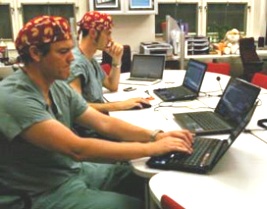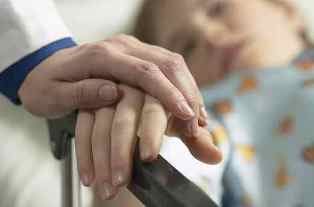September 19th, 2010 by Maria Gifford in Better Health Network, Expert Interviews, Health Tips, Research
Tags: #txfm2010, Body Weight, Diet and Exercise, Diet and Nutrition, Dr. Jim Levine, Food and Nutrition, Human Energy Requirements, Human Nutrition, Maintain weight, Maria Gifford, Mayo Clinic Transform 2010, Metabolism, Muve, NEAT, Non-Exercise Activity Thermogenesis, Nutrition and Health, Obesity, Physical Activity, Physiology, Treadmill Desk, Trek Desk, Undernutrition, Walk At Work, Walkstation, Weight Control, Weight Management
No Comments »
 Obesity doesn’t stand a chance against Dr. Jim Levine, one of the prestigious presenters at Mayo Clinic’s Transform 2010 conference last week. Dr. Levine’s fascinating research focuses on helping people understand obesity, weight reduction, and Non-Exercise Activity Thermogenesis (NEAT) — the idea that expending calories through the activities of daily living is more important for calorie burning than exercise is.
Obesity doesn’t stand a chance against Dr. Jim Levine, one of the prestigious presenters at Mayo Clinic’s Transform 2010 conference last week. Dr. Levine’s fascinating research focuses on helping people understand obesity, weight reduction, and Non-Exercise Activity Thermogenesis (NEAT) — the idea that expending calories through the activities of daily living is more important for calorie burning than exercise is.
Dr. Levine’s “Treadmill Desk” has won more than 50 national and international awards in science, including the Judson Daland prize from the American Philosophical Society, the Invention of the Future Award from NASA, and the Innovation Award at the World Fair. The “Walkstation” is now a product of Steelcase.
Dr. Levine’s work has been highlighted nationally around the world, and he has produced documentary films with the BBC, ABC, and CNN. His Walkstation has been featured in The New York Times, his vision of a future where office people walk at work in USA Today, and his Treadmill Desk tested live on Good Morning America. Read more »
September 18th, 2010 by Medgadget in Better Health Network, News, Research
Tags: Anesthesiology, General Surgery, Italy, McGill-McGill University Health Centre, Montreal, Pisa, Preoperative Assessment At Home Via Teleconference, Remoted-Performed Surgery, Surgery Via Teleconference, Surgery Videoconferencing, Teleanesthesia, Thyroid Gland Surgery, Transcontinental Anesthesia
No Comments »

 Just two weeks after we reported on teleanesthesia in the form of remotely-performed nerve blocks, the first report of transcontinental anesthesia comes in.
Just two weeks after we reported on teleanesthesia in the form of remotely-performed nerve blocks, the first report of transcontinental anesthesia comes in.
On August 30, anesthesiologists of McGill-McGill University Health Centre in Montreal, kept watch over a patient in Pisa, Italy, undergoing thyroid gland surgery. Basically they used a teleconferencing setup with four cameras, with two cameras streaming the anesthesia data (ventilation parameters and vital signs), one camera aimed at the operating field, and the last one for any special purposes. Read more »
*This blog post was originally published at Medgadget*
September 18th, 2010 by Toni Brayer, M.D. in Better Health Network, Health Policy, News, Opinion, Research
Tags: Art of Medicine, Comforting a Patient, Dehumanization, Doctor's Hug, Emotional Component, Emotional Support, Emotional Time, General Medicine, Hand Holding, Holding a Patient's Hand, Holding Hands, Hugging, Human Compassion, Human Touch and Medicine, Lay On Hands
No Comments »

 The New York Times asks: “Should the doctor hold a patient’s hand” during emotional times? The comments that follow the short article are the most interesting. Most readers say this question shouldn’t even be asked and that human compassion should always win out. Touch is a human gesture of comfort and understanding.
The New York Times asks: “Should the doctor hold a patient’s hand” during emotional times? The comments that follow the short article are the most interesting. Most readers say this question shouldn’t even be asked and that human compassion should always win out. Touch is a human gesture of comfort and understanding.
But some readers disagree. One said she recoiled when the doctor reached out to touch her hand after telling her that her cancer had returned. It felt really creepy to her. Another asked: “What if the physician is also a Catholic priest or a pediatrician and a priest?” Whoa. It becomes more complex when you get into the psyche of the abused.
I have often thought that one of the appeals of chiropractors is that they “lay on hands” and touch and manipulate patients. With 21st century modern medicine, physicians can treat entire episodes of illness with tests, scans and robots and never actually touch the patient. No wonder people feel “dehumanized” and wonder if doctors really care. Touch and compassion are part of the entire human experience and the physician is present during a patient’s most stressful time. But wait, there’s another side. Read more »
*This blog post was originally published at EverythingHealth*
September 17th, 2010 by RyanDuBosar in Better Health Network, News, Research
Tags: Ambulatory Care, Archives of Internal Medicine, Change Doctors, Doctor-Patient Communication, Family Medicine, Finding A New Doctor, General Medicine, Medical Errors, Medical Mistakes, Mistakes In Patient Care, Normal Diagnostic Challenges, Normal Therapeutic Challenges, North Carolina, Patient Expectations, Patient Safety, Patient-Doctor Confrontation, Patient-Doctor Relationship, Picking A Better Doctor, Primary Care, Reuters Health, Switch Doctors, Wrong Diagnosis, Wrong Treatment
No Comments »

Patients won’t confront doctors if they think there’s been a mistake. They’ll just find a new doctor, even if there’d been no medical error.
Researchers looked at adult visits to seven primary care practices in North Carolina during 2008. They asked patients about their perceptions of medical mistakes and how did it influence the choice to switch doctors.
Of 1,697 patients, 265 (15.6 percent) reported a mistake had been made, 227 (13.4 percent) reported a wrong diagnosis, 212 (12.5 percent) reported a wrong treatment, and 239 (14.1 percent) reported changing doctors as a result. Results appeared in the Archives of Internal Medicine.
But anecdotes cited by patients as mistakes were often normal diagnostic or therapeutic challenges. A typical scenario might be the patient reported symptoms, the doctor did not correctly diagnose it at first presentation, and a specialist or second physician offered a specific diagnosis. Other scenarios included medication trials or side effects from the prescription. Read more »
*This blog post was originally published at ACP Internist*
September 16th, 2010 by Mark Crislip, M.D. in Better Health Network, Opinion, Research
Tags: Accuracy in Diagnosis, CDC Criteria, Centers For Disease Control and Prevention, CFS, Chronic Fatigue Syndrome, Disease Patterns, DNA, Good Diagnosticians, Molecular Biochemistry, Post-Infectious Disease, Psychiatry and Psychology, Science Based Medicine, Xenotropic Murine Leukemia Virus-Related Virus, XMRV
No Comments »

Humans love to find patterns in the world. Sometimes patterns exist, sometimes they are imaginary. Sometimes you can see a pattern that may be interesting and ignore its significance. As a resident I used to say that anyone who smokes three packs of cigarettes a day has to be schizophrenic. It was meant more as a joke when, in fact, it was later discovered that tobacco helps ameliorate the symptoms of schizophrenia. I need to pay more attention.
Part of my job is to look for patterns as a key to the patients diagnosis. Diseases and pathogens tend to (more or less) cause reproducible signs and symptoms and looking for that pattern is often the most helpful clue towards finding the diagnosis. Of course things are never as easy as one would like, as you have to consider whether you are seeing common manifestations of a common disease, uncommon manifestations of a common disease, common manifestations of a uncommon disease and, the hardest, uncommon manifestations of an uncommon disease. When I have a complex or uncertain cause, I explicitly run through that, and other, litanies so I do not miss a unusual diagnosis.
Chronic fatigue syndrome (CFS) has, at least to my way of thinking, two patterns. I see the occasional CFS patient in clinic and, I hope, pay attention to their disease patterns. I keep in mind I may be seeing a pattern that does not exist, but looking for disease patterns is what doctors are trained to do. Read more »
*This blog post was originally published at Science-Based Medicine*
 Obesity doesn’t stand a chance against Dr. Jim Levine, one of the prestigious presenters at Mayo Clinic’s Transform 2010 conference last week. Dr. Levine’s fascinating research focuses on helping people understand obesity, weight reduction, and Non-Exercise Activity Thermogenesis (NEAT) — the idea that expending calories through the activities of daily living is more important for calorie burning than exercise is.
Obesity doesn’t stand a chance against Dr. Jim Levine, one of the prestigious presenters at Mayo Clinic’s Transform 2010 conference last week. Dr. Levine’s fascinating research focuses on helping people understand obesity, weight reduction, and Non-Exercise Activity Thermogenesis (NEAT) — the idea that expending calories through the activities of daily living is more important for calorie burning than exercise is.


 Just two weeks after we reported on teleanesthesia in the form of
Just two weeks after we reported on teleanesthesia in the form of 
 The New York Times asks: “Should the doctor hold a patient’s hand” during emotional times? The comments that follow the
The New York Times asks: “Should the doctor hold a patient’s hand” during emotional times? The comments that follow the 









